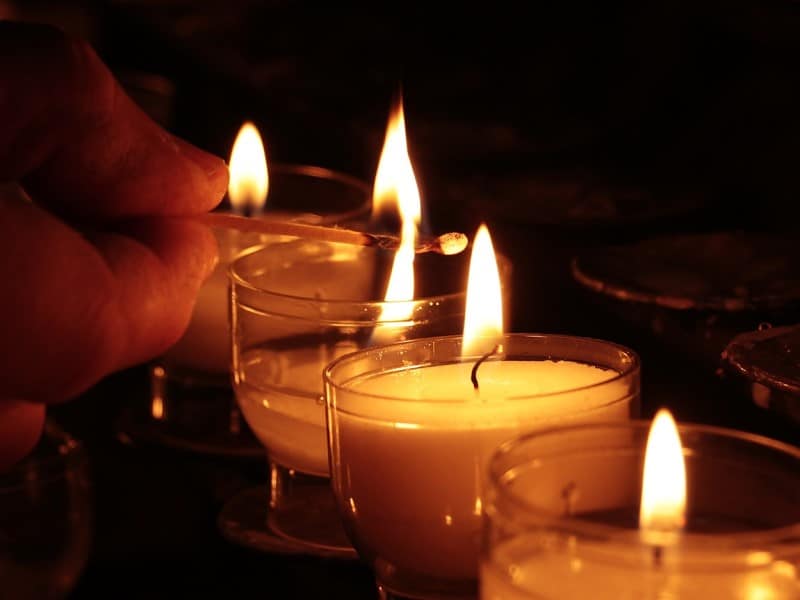Burning a candle is a great way to relax and fill your home with fragrance. No matter what fragrance you choose or where you choose to place your candle, there’s no doubt that your home will feel a bit more relaxed and will be filled with a fragrance you love.
The bad part about burning candles is that they don’t last forever. Eventually, there won’t be any wax left in your jar to burn. But where does that wax go?
When you burn a candle, the wax evaporates into the atmosphere of whatever room you place it in. Because it evaporates, the wax in your jar will slowly disappear until it is all used up.
There is a whole process your candle wax goes through to get from a solid wax to being evaporated. In this post, I’ll tell you everything you need to know about what happens to your candle wax when you burn your candle.
While your candle wax evaporates when you burn your candle, if you use wax melts, your wax won’t evaporate so you can continually reuse it. With candles, you can reuse the jar but not the wax because the wax evaporates.

Why the Candle Wax Evaporates?
When you burn a candle, the wax is actually what is burning and not the wick. The wick is coated in wax to get the flame started and as you burn your candle, the wax works its way up the wick to keep the flame going. This process leads to your wax evaporating.
When you first light your candle, your wax goes through a process to turn from a solid form into a gaseous form after it evaporates. From the moment you light the wick, the process begins and your wax begins to warm. The heat from the wick begins to turn your solid candle wax into a liquid form. As the candle wax turns into a liquid, it works its way up through the wick through capillary action.
Once the wax makes its way up through the wick, it heats up even more from being in direct contact with the flame. From the increase in the heat, the wax then evaporates and enters the atmosphere in your home in a gaseous state.
There is actually a scientific explanation of this process. When the wax is brought up into the flame, a reaction takes place to change the state of the wax. The wax breaks up into molecules of hydrogen and carbon, called hydrocarbons, and then reacts with the oxygen in the air to produce heat, light, water vapor, and carbon dioxide. So when your candle wax evaporates, it breaks down as it enters the atmosphere.
Because the wax evaporates when it gets to the flame, it hovers in the air around the candle for some time. When you blow out a candle, the smoke that you see rising from the extinguished wick is actually gaseous candle wax. The wax is the part of the candle that is on fire, not the wick, which opens up a trick that you can perform with the gaseous wax.
The trick that some people do to impress their friends after they extinguish their candle is to hold a lighter to the smoke that comes from the wick. The smoke then helps the flame travel down to the wick to relight the candle without the lighter ever coming near the wick. While this is a cool party trick, this trick can pose a fire risk and isn’t recommended.
How does Different Waxes Affect Evaporation?
When you burn different candles you may notice that some last longer than others. The lifespan of a candle’s burn time doesn’t necessarily rely on the size of the candle. For example, Bath & Body Works sells their candles in two sizes: a large 3-wick and a smaller single-wick candle. These candles have roughly around the same burn time despite the fact that they are two different sizes.
While this also has to do with the number of wicks in the container, it also is the result of the candle being made from the same type of wax. If you were to burn two candles that are the same size but different waxes, you may notice that one will burn slower than the other.
This could even work if you use different sizes of candles. You won’t necessarily always see the smaller candle burn faster than the larger candle, either. Read more about How Long Do Scented Candles Last? (with calculator and 5 examples).
The type of wax being used can affect your burn time. Paraffin wax is a popular wax to use because it provides a strong scent throw so it’s ideal for use in a large room. This wax tends to burn quickly, though, so you don’t get as long of a burn time as you would with other types of waxes.
Natural waxes, such as beeswax and soy wax, are a more expensive wax and don’t provide as strong of a scent throw as paraffin, even though the scent throw you do receive can be considered strong.
The high price comes from the waxes being natural but it’s worth it if you want a long lasting candle. Natural waxes have a slower burn rate, which means that your candle will melt and evaporate at a slower rate.
Picking the right type of wax for your needs is essential. If you’re looking for a strong scent throw that can easily fill a large room, then paraffin wax could be a good choice for you. But, if you want a long lasting candle with a slow burn, natural waxes are the best way to go. Many candle companies use soy wax because it is less expensive than beeswax and because it can be easily grown.
Do Wax Melts Evaporate too?
While candles are a great way to add fragrance to your home, it’s not always a plausible method. If you have small children and don’t want an open flame around them or if you live in a place where you’re not to burn a candle, there are alternatives. Wax melts and a wax warmer are a great alternative because they can be electric and don’t require a flame.
When using wax melts, you may be wondering if the melts evaporate like the wax in candles do. Wax melts actually don’t evaporate.
The amount of heat that’s needed to make wax evaporate isn’t provided by a wax warmer so the wax won’t evaporate. Instead, the wax will just lose its fragrance so you’ll be left with scentless wax after using it for a while.
When your wax melts lose their scent, you can make newly fragranced melts by adding essential oil or fragrance oil. Because they don’t evaporate, you’ll be able to use this wax time and time again. You can also use this wax to create a candle when it loses its scent but it will evaporate when you burn it as a candle.
Read more: Do Essential Oils Evaporate
Final Thoughts
When you burn a candle, the question of where the wax goes probably crosses your mind at some point. You never want your favorite candle to run out of wax but unfortunately, it’s an unavoidable feature with candles.
If you want a long lasting candle with a slow burn, you may want to find or make candles that are made with natural waxes, such as beeswax or soy wax.
If you want an alternative to candles that don’t evaporate, you can get a wax warmer and some wax melts. While it’s nice that they don’t evaporate, they do lose their fragrance. You’d be able to reuse them and add fragrance or make them into a candle, which will then end with the wax evaporating. Evaporating wax is an inevitable feature with candles, but the fragrance they give you is definitely worth it.
